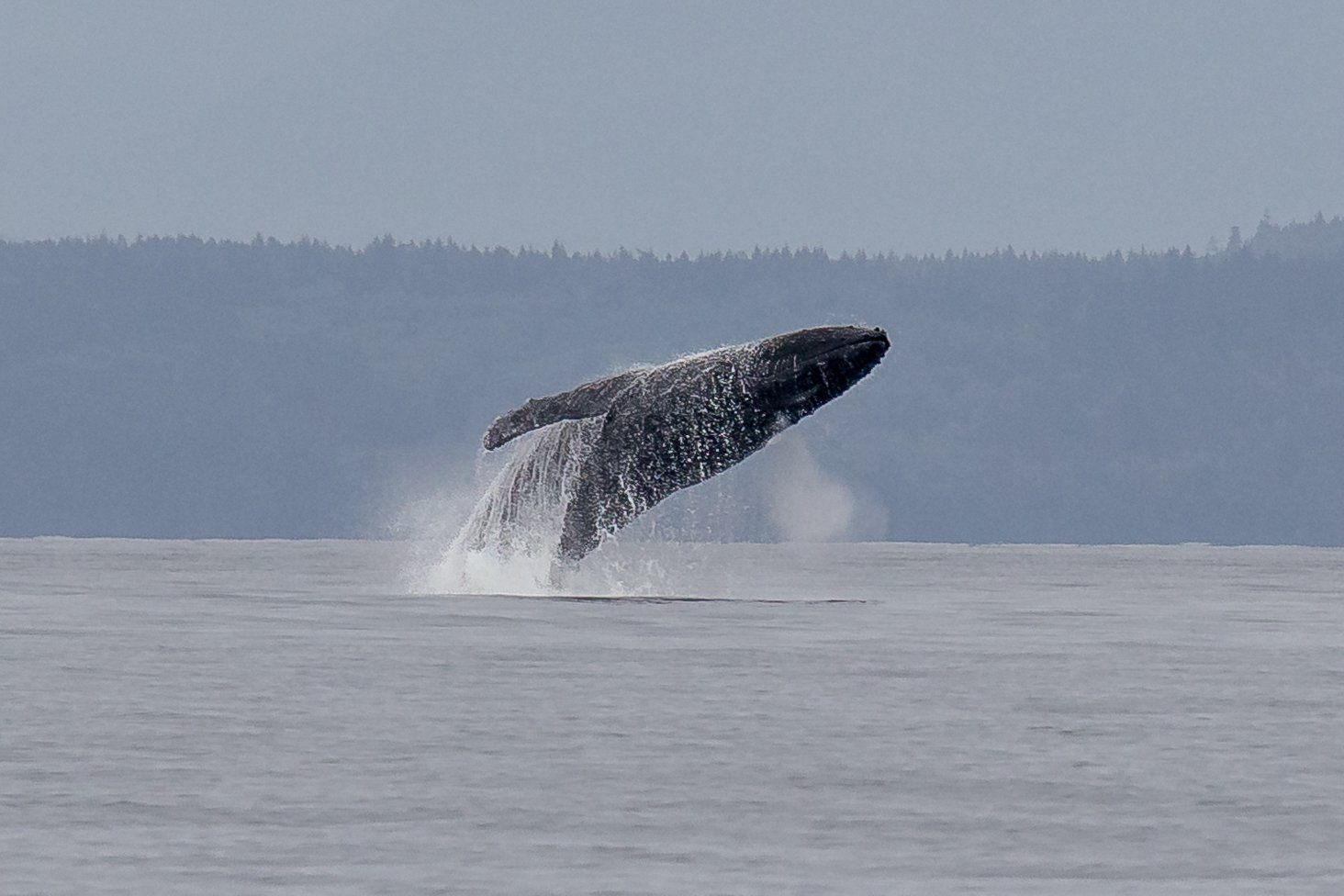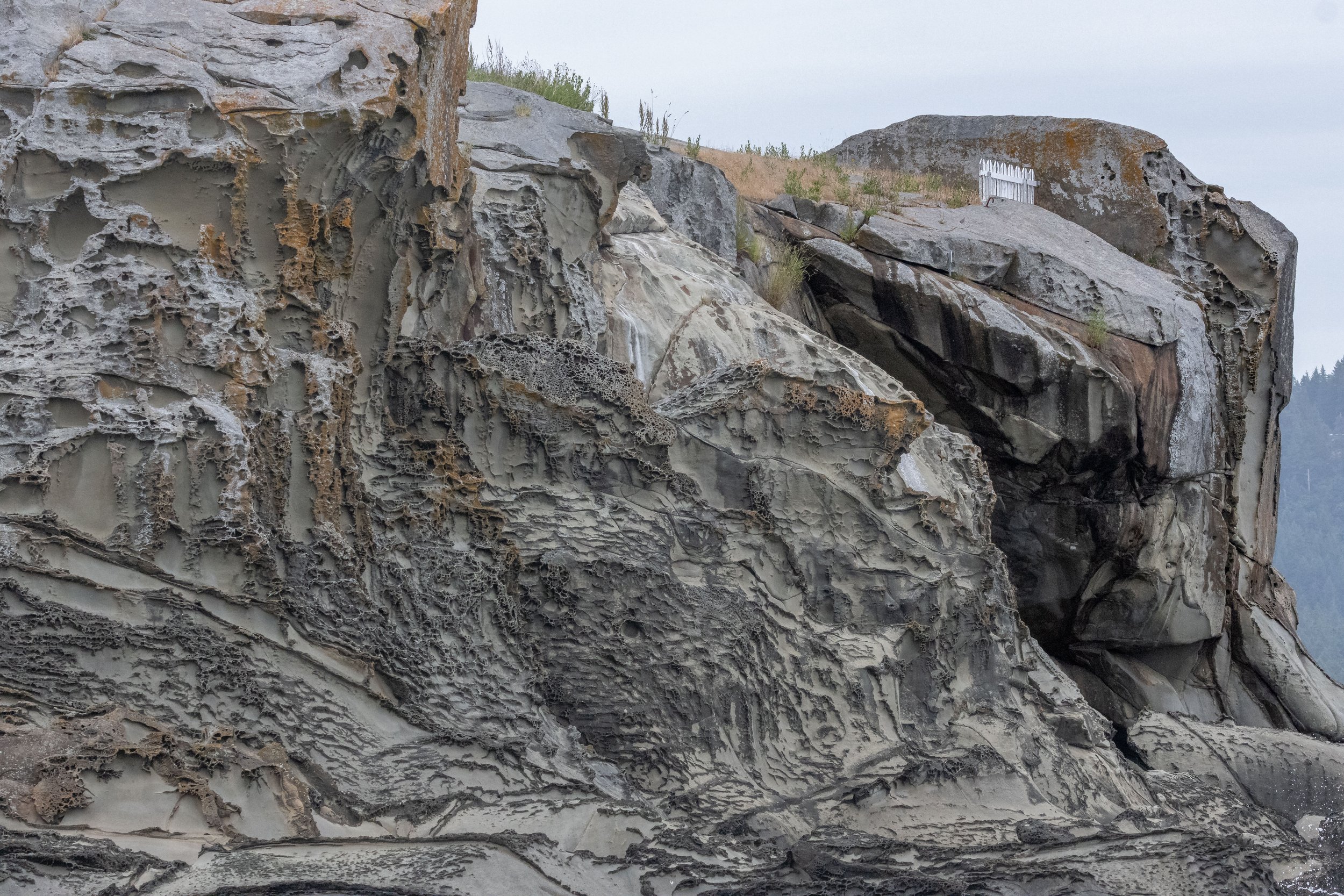June 15, 2023 3:30 - T-party with a side of Humpbacks
Quite an exciting afternoon for all our vessels! We had a special charter that was leaving from further north, in French Creek. Since we usually depart from the Nanaimo harbour, it added extra excitement since it would be able to access areas that are usually too far north for a typical tour. We also had our regular tour depart from the Nanaimo Harbour on Kula this afternoon. Each group ended up having pretty different experiences, but both were amazing!
Let’s start with our Northern boats. They headed out from French Creek and started the Search around the Northern sections of the Strait of Georgia. One boat went more west, towards Hornby and Denman Islands while the other headed over closer to Lasqueti and Texada Islands. It wasn’t long before we spotted a blow in the distance! As we came closer we started to get a good look at the whale. It was a humpback whale with two more in the distance! The first one that we spent time with we were able to ID as Big Mama’s 2022 calf Moresby (BCY0324 calf 2022)! Although their tail has changed quite a bit since we saw them last year travelling with their mom, there were enough similarities that we pulled up their more recent photos from HappyWhale and were able to confirm it!
After spending some time with Moresby we headed over to the other two humpbacks that were travelling together. A couple of fluke shots later and we knew we were with Graphite (KEX0059), and Ocular (BCX1705)!
Graphite (Slate’s 2019 calf) was travelling in close quarters with Ocular in what we think is a socialization behaviour. It’s not known exactly why the humpbacks will travel together, but it’s becoming the norm with them now! Researchers used to think that humpbacks were solitary creatures but that was just when they started researching them in the wild after they were targeted by the whaling industry. With their low numbers back then, it seems probable that they just didn't have high enough numbers to find each other to travel with. Some theories as to why they tend to hang out in pairs are that they might be helping each other be more efficient in their feeding, they could be forming groups to deter predators, or it might just be purely social! As more research is done on these amazing animals hopefully some of these questions will be answered in the future!
After our time with the whales, we headed back to French Creek, and there we found one final animal to look at! It was a Bald Eagle! Eagles are commonly found in Harbour environments since the docks and protected areas make for good fishing. The cover of the docks are often used as the fish for nurseries as their young will be protected better than in the natural environment. But because of the protection from the winds the water is easy to see through if you are an eagle, which makes catching lunch much easier! Other birds will take advantage of the high densities of fish in the area as well so birds like King Fishers, Great Blue Herons, and Cormorants are very common.
After seeing our Eagle, it was time to drop everyone off!
While this adventure was unfolding our regular public tour was heading out to find their own whales. Since they left from Nanaimo, they headed over to a previous report of Orca near Vancouver! We headed in that direction and soon found the small black dorsal fins of the T046B1’s, T046C2, and T087 travelling together.
All the whales that were present today are:
T046B1 Tread ♀ (2003)
T046B1A Tsakani ♀ (2015)
T046B1C (2022)
T046C2 Sam ♀ (1994)
T087 Harbeson ♂ (~1962)
T087 Harbeson is beating the odds in regard to his age. He is the oldest known male in the Transient Orca population! While most male orca don’t tend to live past their thirties, Harbeson is now 61 years old! The reason that males tend to not live as long as the female orca (the females can be 100 years old!) is because of the toxins in their bodies. The female orca are able to pass these toxins through having calves and through their milk, whereas the males don’t have any way to get rid of the toxins. This means that they build up in their bodies for longer and might contribute to their shorter life span. It may also be partially due to their larger bodies.
Today our orca were just travelling together through the Strait, it was a very serene experience watching them moving in and out of the waters.
After we spent some time with the orca, we headed out to see what else we could find! As we were travelling and searching, a blow in the distance caught our eye! We headed in that direction and soon found a playful humpback whale. This humpback was slightly harder to ID since they had no obvious markings on their tail flukes, and no big chunks missing from their tail flukes. After some investigation in the Keta Catalogue, we found the whale was Incognito (BCX2053). Incognito was very active at the surface, tail slapping and pec slapping as they moved through the water.
We watched Incognito for a little while until our time was up then we headed back to Nanaimo. Although very different experiences by our northern and southern boats today, both got to see a ton of wildlife and whales!
The photos from the day are available to view below and were taken by the onboard naturalists Aly Kohlman (public tour), Des Poier (charter) and Vanessa Verschahen (charter).
Moresby going for a dive. Photo by Des Poier.
Moresby’s tail flukes. Photo by Vanessa Vereschahen.
Graphite going down for a dive. Photo by Des Poier.
Ocular surfacing. You can see right up their nostrils! Photo by Des Poier.
Ocular going for a dive. You can clearly see his entanglement scarring. Photo by Des Poier.
Ocular diving with another humpback’s nostrils in the side of the frame. Photo by Des Poier.
The underside of Ocular’s tail flukes. Photo by Des Poier.
Graphite preparing to dive. Photo by Des Poier.
Continuation of Graphite’s tail flip! Photo by Des Poier.
Graphite Preparing to dive. Photo by Des Poier.
Graphite doing a head stand! Photo by Des Poier.
The underside of Graphite’s tail flukes. He has very subtle white markings along the edge of his tail. Photo by Des Poier.
Graphite diving. Photo by Des Poier.
Look at that waterfall off of Graphite’s Flukes! Photo by Vanessa Vereschahen.
Ocular Breaching! Photo by Vanessa Vereschahen.
Takeoff! Another breach from Ocular. Photo by Vanessa Vereschahen.
Coming in for a landing. Photo by Vanessa Vereschahen.
Touchdown! Ocular’s back in the water. Photo by Vanessa Vereschahen.
T087 Harbeson. Photo by Aly Kohlman.
T087 Harbeson. Photo by Aly Kohlman.
T046C2 Sam. Photo by Aly Kohlman.
T087 Harbeson. Photo by Aly Kohlman.
T046B1 Tread in front of one of her kids, to the right is the tip of T087 Harbeson’s dorsal. Photo by Aly Kohlman.
Incognito tail flick! Photo by Aly Kohlman.
Another exciting dive from Incognito. Photo by Aly Kohlman.
Incognito’s Pectoral fin. Photo by Aly Kohlman.
A Bald Eagle perched near the lighthouse. Photo by Vanessa Vereschahen.
A group of Steller Sea Lions on Sticky Rock. Photo by Aly Kohlman.
Look at the size difference between the adult male and the others! Photo by Aly Kohlman.
Stampede! Photo by Aly Kohlman.
They’re just as comfortable in the water as on land, sometimes more so! Photo by Aly Kohlman.
Chrome Island Lighthouse. Photo by Des Poier.
Another example of the erosion in the sandstone, this time further north off Denman Island! Photo by Des Poier.
Our Happy Guests on the Charter! Photo by Vanessa Vereschahen.


































